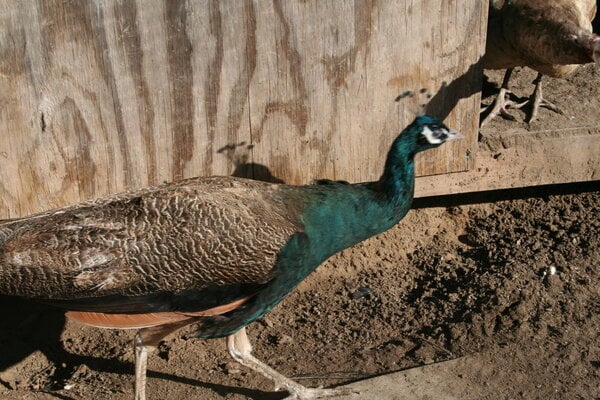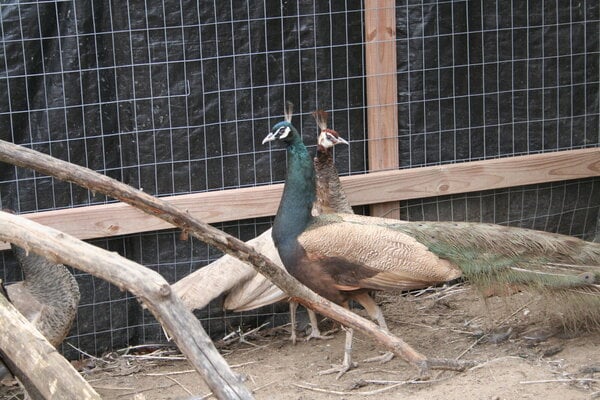Indigo and hazel are sister mutations and were among the first instances of double recessive mutation expression in the peafowl world. They are a combination of Bronze mutation and Purple mutation and though they genetically are the same appearance wise they are very different. Indigos appeared first in the early 2000's at Roughwood Aviaries as the final result of a project by legendary peafowl breeder Cliff Nicholson. Until then it was not known if two colors could combine or be expressed at the same time without crossover occurring (as was the case of the Peach mutation). Hazel first appeared at Texas Peafowl farm as a Silver Pied bird and was propagated from there. Indigo as a color strongly favors its purple heritage with a deep navy blue neck, muted green saddle, and coco brown coverts on the wings. Tail feathers are a muted green with deep blue ocelli. Indigo hens are light brown with blue iridescence on their necks. Hazel by contrast strongly favors the Bronze side of the equation with a darker train and dark bluish purple neck feathers. When young Hazel roosters very very closely resemble Bronze males and close examination is needed to tell them apart. Hazel hens are a light brown with a bit of iridescence on the neck. If you're not familiar with the color you might say the hens look like cameo hens but the iridescent neck gives it away. Breeding these birds is interesting because of the double gene factor here are some combos.
Indigo/hazel+Indigo/Hazel= 100% Indigo/Hazel
Indigo/Hazel male+ Bronze hen= Bronze split indigo/hazel roosters and 100% Indigo/Hazel Hens
Indigo/Hazel Hen + Bronze Rooster= Bronze hens and Bronze split Indigo/Hazel roosters
Indigo+Hazel (gender is irrelevant)= 50% Indigo 50% Hazel
Indigo split Hazel+ Indigo split Hazel= 75% Indigo 25% Hazel (If the pairing is 2 Hazel split Indigo the ratio is the opposite)
Indigo/Hazel + India blue hen= Purple carrying Bronze hens, India blue carrying Purple and Bronze roosters
India Blue rooster+ Indigo/Hazel hen= India blue split Bronze hens, India blue split bronze and purple roosters.
Hope this was helpful.
Indigo/hazel+Indigo/Hazel= 100% Indigo/Hazel
Indigo/Hazel male+ Bronze hen= Bronze split indigo/hazel roosters and 100% Indigo/Hazel Hens
Indigo/Hazel Hen + Bronze Rooster= Bronze hens and Bronze split Indigo/Hazel roosters
Indigo+Hazel (gender is irrelevant)= 50% Indigo 50% Hazel
Indigo split Hazel+ Indigo split Hazel= 75% Indigo 25% Hazel (If the pairing is 2 Hazel split Indigo the ratio is the opposite)
Indigo/Hazel + India blue hen= Purple carrying Bronze hens, India blue carrying Purple and Bronze roosters
India Blue rooster+ Indigo/Hazel hen= India blue split Bronze hens, India blue split bronze and purple roosters.
Hope this was helpful.





